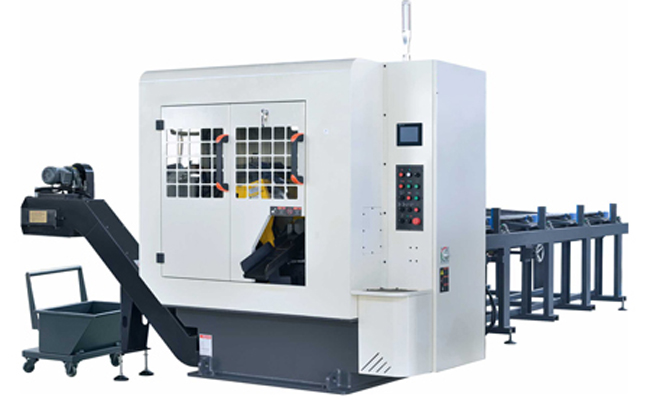CS-275 Circular Saw
Cutting Capacity :
A CNC circular saw machine is a circular saw device that uses CNC technology to achieve automated, high-precision cutting. It combines the cutting function of a traditional circular saw machine with the precise control capabilities of a CNC system. It is widely used in metal processing, wood processing, plastic processing and other fields, especially in industrial production that requires fast and precise cutting. Choosing a suitable CNC circular saw machine requires comprehensive consideration of factors such as materials, precision, and production scale to maximize production benefits.

Main features of CNC circular saw machines:
1. High-precision cutting: The position, speed and feed rate of the saw blade are precisely controlled by the CNC system to achieve millimeter-level or even higher precision cutting. Suitable for workpieces with high dimensional accuracy requirements, such as mechanical parts, profiles, etc.
2. Automated operation: Programmable control of cutting paths and parameters to reduce manual intervention and improve production efficiency. Supports mass production and high precision in repeated cutting.
3. Versatility: Can cut a variety of materials, including metals (such as steel, aluminum), wood, plastics, etc. Some models support complex processing such as beveling and angle cutting.
4. Fast energy saving: Optimizing cutting parameters can reduce material waste and energy consumption. Fast tool change and automatic feeding system improve production efficiency.
5. Safe and reliable: Equipped with safety protection devices (such as protective covers, emergency stop buttons) to reduce operating risks. The CNC system can monitor the equipment status in real time to avoid failures.
The core components of CNC circular saw machine:
1. CNC system: Control the movement trajectory, cutting speed, feed amount and other parameters of the saw blade. Support programming input (such as G code) or graphical interface operation.
2. Saw blade drive system: High-power motor drives the saw blade to rotate and provide sufficient cutting force. Some models use variable frequency speed regulation technology to meet the cutting needs of different materials.
3. Feeding system: Automated feeding device to accurately deliver the workpiece to the cutting position. Support straight line, curve or angle feeding.
4. Clamping device: Fix the workpiece to prevent movement or deformation during cutting. Hydraulic or pneumatic clamping method to ensure stability.
5. Safety protection device: protective cover, light curtain, emergency stop button, etc. to ensure the safety of operators.
Application fields of CNC circular saw machine:
1. Metal processing: cutting steel pipes, profiles, plates, etc., used in construction, automobile, machinery manufacturing and other industries.
2. Wood processing: cutting solid wood, artificial boards, etc., used in furniture manufacturing, building template production.
3. Plastic processing: cutting plastic profiles and pipes, used in packaging, pipeline manufacturing and other fields.
4. Other fields: cutting of special materials such as composite materials and ceramics.
How to choose CNC circular saw machine:
1. Select according to materials: metal cutting requires high-power and wear-resistant saw blade models. Wood cutting requires consideration of saw blade speed and feed speed.
2. Select according to accuracy requirements: high-precision requirements (such as ±0.1mm) require high-end CNC systems.
3. Select according to production scale: small batch production can choose economical models, large batch production requires high-automatic models.
4. Consider after-sales service: choose a brand with perfect after-sales service to ensure long-term and stable operation of the equipment.
Comparison of the advantages of CNC circular saw machines and ordinary circular saw machines:
| Feature | Ordinary Circular Saw Machine | CNC Circular Saw Machine |
|---|---|---|
| Precision | Low, relies on manual operation | High, precise CNC system control |
| Efficiency | Low, requires frequent parameter adjustments | High, automated operation, batch production |
| Flexibility | Low, limited functionality | High, supports complex cuts and programming |
| Safety | Low, higher risk due to manual operation | High, equipped with safety guards |
| Application | Small-scale, low-precision needs | Large-scale, high-precision needs |
Cutting Capacity :
Cutting Capacity :